The document is a seminar report submitted by Alin Babu on the topic of secure cloud storage. It discusses cloud computing models and services, different access control mechanisms like mandatory access control and discretionary access control. It also covers secure data storage using AES encryption and the Disintegration Protocol (DIP) architecture for enhancing cloud security. Proxy re-encryption schemes and their advantages for secure file sharing in cloud applications like Dropbox and SugarSync are also summarized.

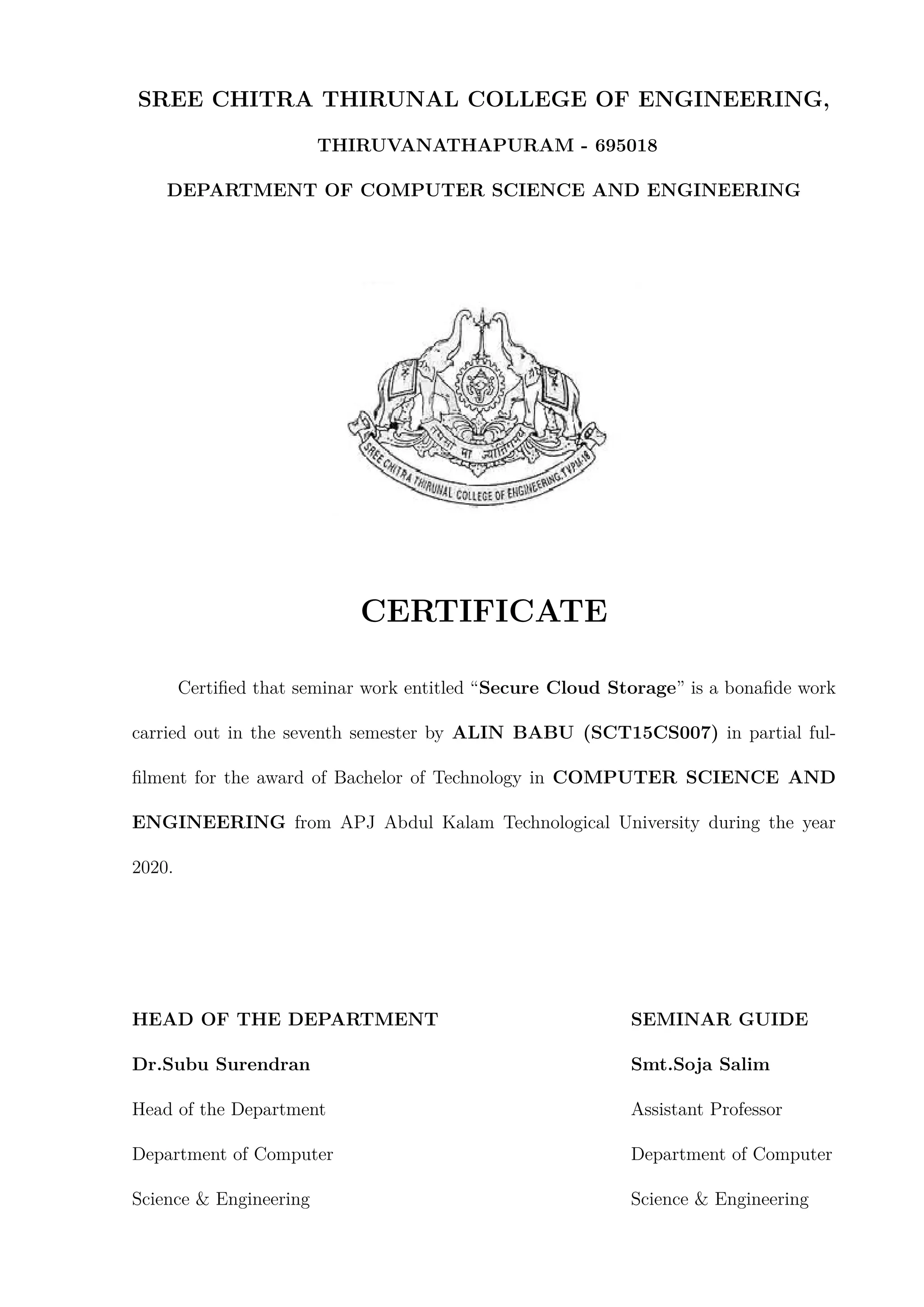



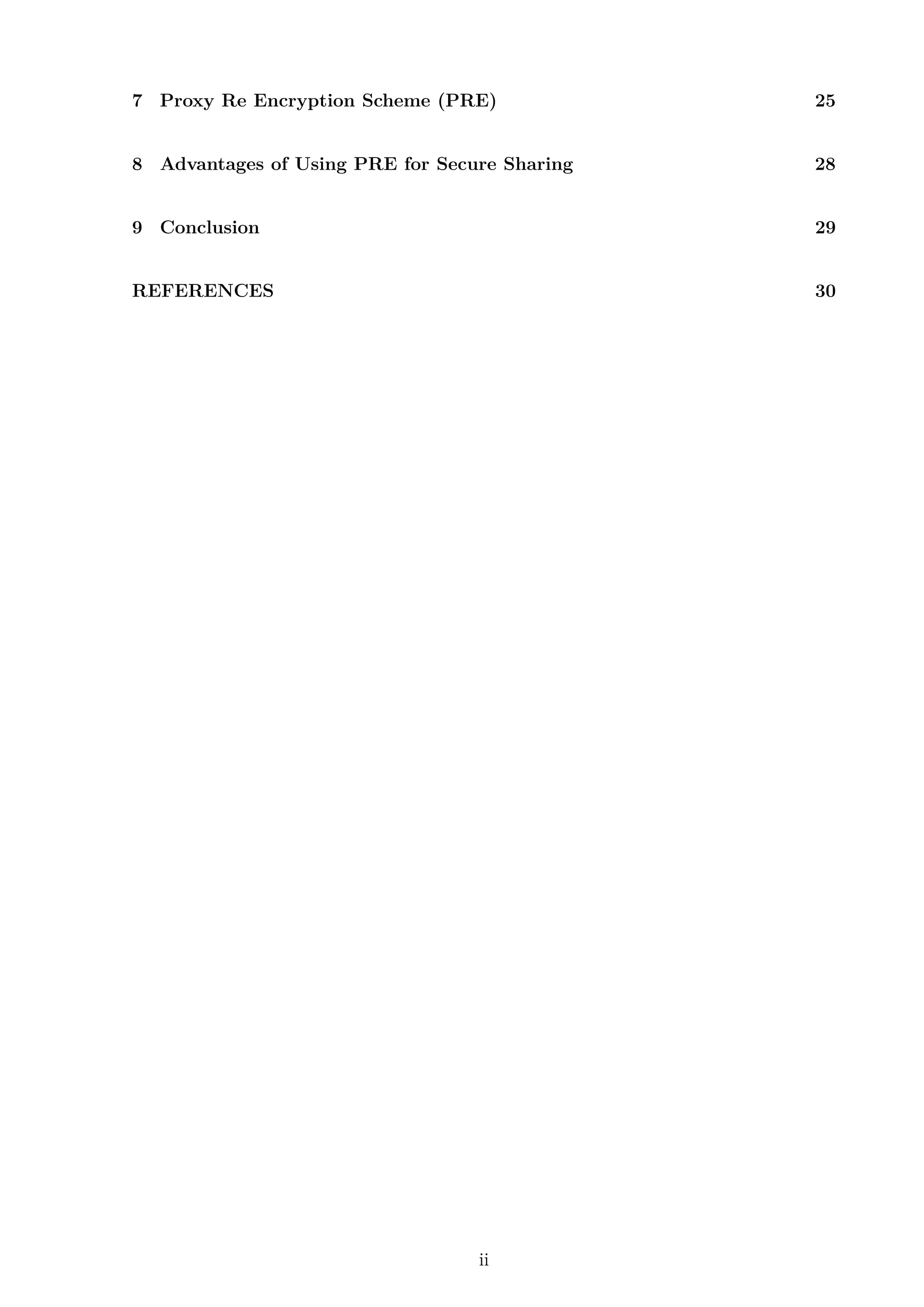

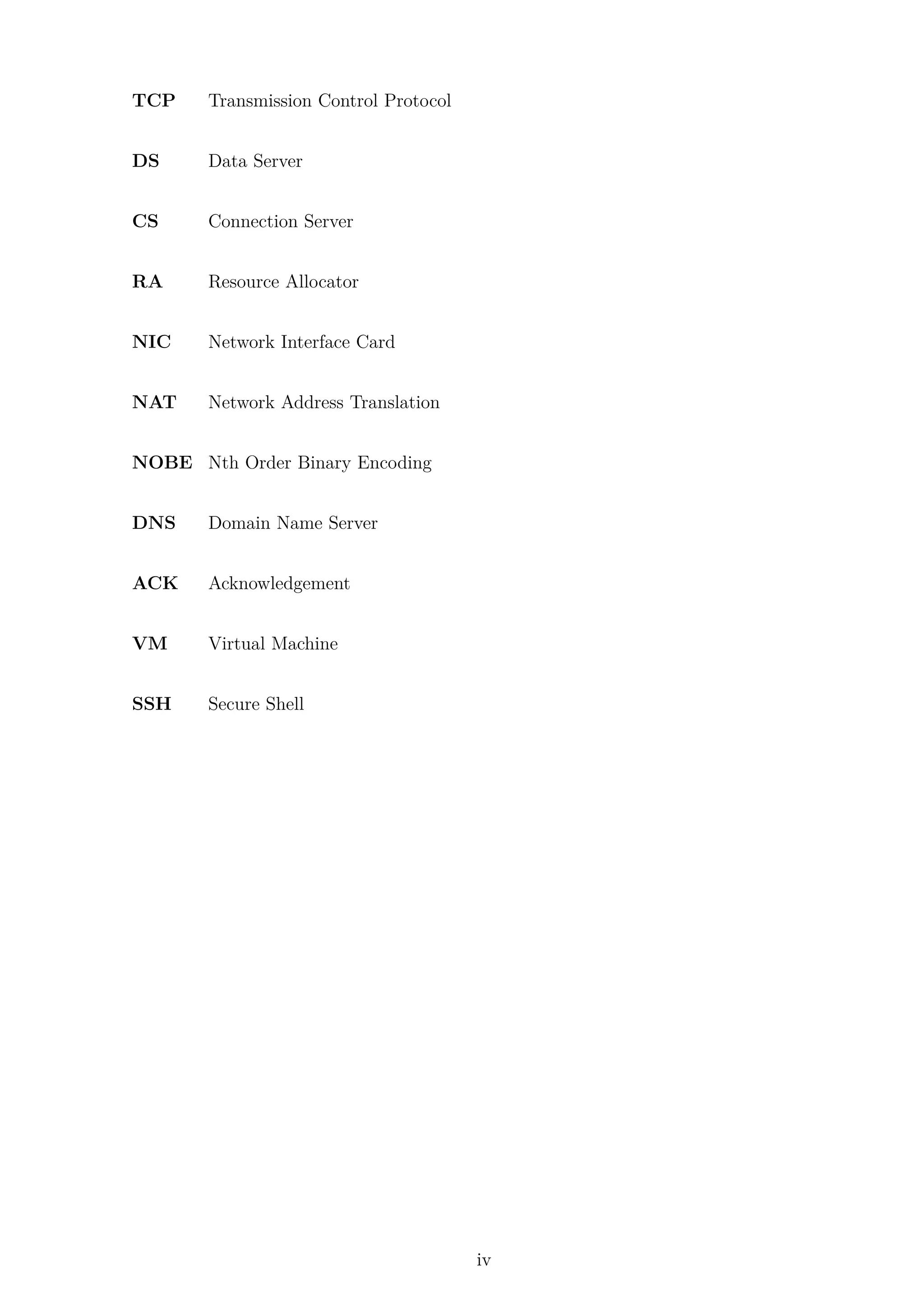



![CHAPTER 2
CLOUD COMPUTING
Cloud Computing is a set of IT Services that are provided to a customer over a network
and these services are delivered by third party provider who owns the infrastructure. It
is often provided "as a service" over the Internet, typically in the form of infrastructure
as a service (IaaS), platform as a service (PaaS) and software as a service (SaaS). Cloud
computing is the broader concept of infrastructure convergence [1]. This type of data
centre environment allows enterprises to get their applications up and running faster,
with easier manageability, and less maintenance to meet business demands. For example,
we can manage and store all smartphones or tablets apps at one location i.e. cloud. So
we do not require any memory space at our end. This also gives the security of data and
applications in case device is damaged or lost.
Based on a deployment model, we can classify cloud as:
• Private Cloud
• Public Cloud
• Hybrid Cloud
Based on a service the cloud model is offering, it is classified into three:
• Platform as a Service (PaaS)
• Software as a Service (SaaS)
3](https://image.slidesharecdn.com/report-191129123845/75/Secure-Cloud-Storage-12-2048.jpg)

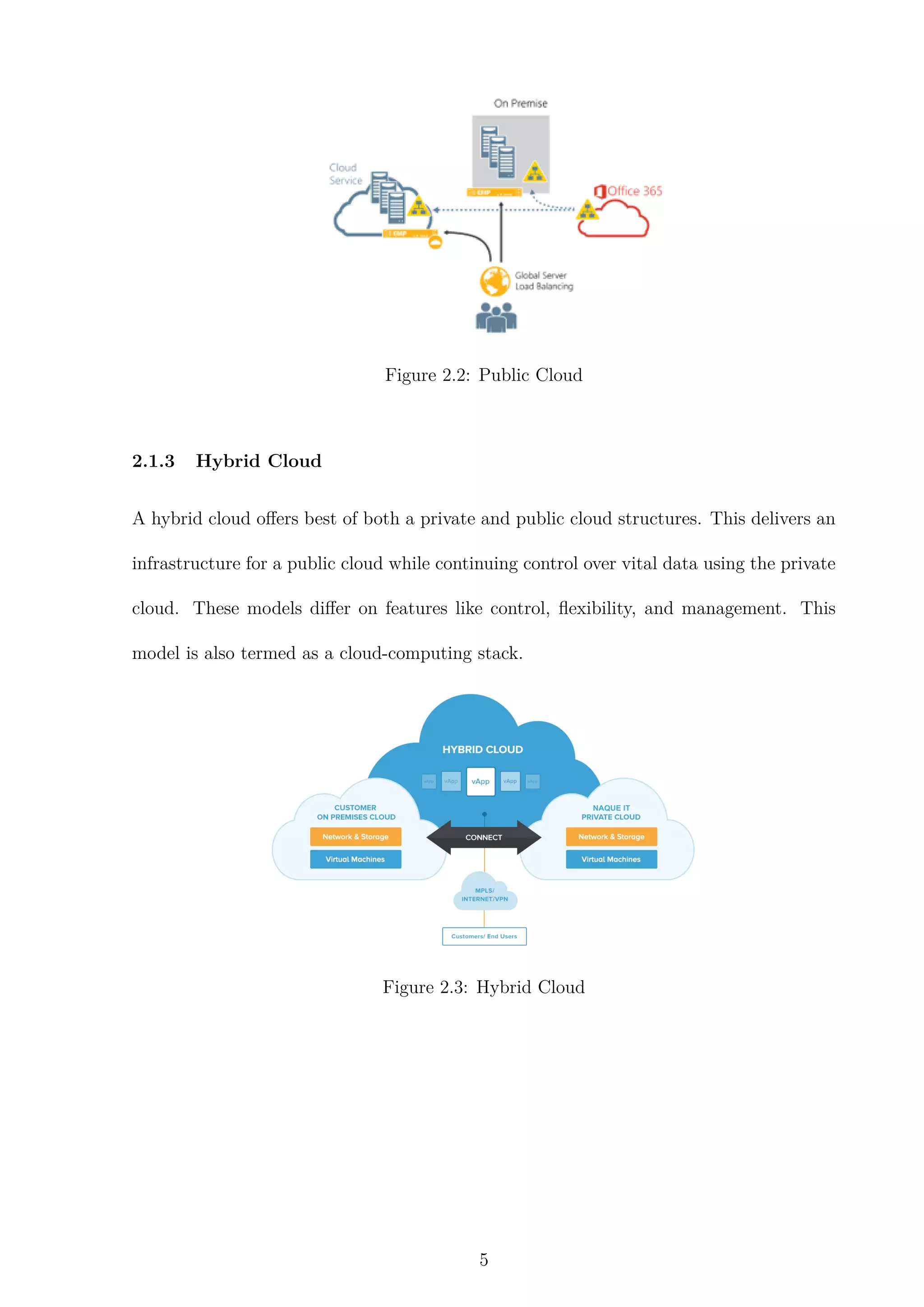






![CHAPTER 4
Secure Data Storage using AES
The security of the data in the cloud database server is the key area of concern in the
acceptance of cloud. It requires a very high degree of privacy and authentication. To
protect the data in cloud database server cryptography is one of the important methods.
Cryptography provides various symmetric and asymmetric algorithms to secure the data.
Symmetric algorithms are more preffered as it has the speed and computational efficiency
to handle encryption of large volumes of data. In symmetric cryptosystems, the longer
the key length, the stronger the encryption. AES [2] is most frequently used encryption
algorithm today this algorithm is based on several substitutions, permutations and linear
transformations, each executed on data blocks of 16 byte. As of today, no practicable
attack against AES exists. Therefore, AES remains the preferred encryption standard for
governments, banks and high security systems around the world.
In, AES data encryption is more scientifically capable and graceful cryptographic
algorithm, but its main force rests in the key length. The time necessary to break an
encryption algorithm is straight related to the length of the key used to secure the com-
munication. AES allows choosing a various type of bits like 128-bit, 192-bit or 256-bit
key, making it exponentially stronger than the 56-bit key of DES.
12](https://image.slidesharecdn.com/report-191129123845/75/Secure-Cloud-Storage-21-2048.jpg)




![CHAPTER 5
Disintegration Protocol (DIP)
The unidirectional, closed and disintegrated protocol that is used to store data to be
securely in the cloud. In general, the server is designed to perform N number of different
tasks (function). In Disintegration Protocol (DIP) [3], we disintegrate N various services
from one server and distribute them among M homogeneous different servers. The DIP
architecture used for the experiments described in this paper is shown in Fig. Although
these experiments were conducted in a WAN environment in the private cloud, as noted
earlier, the proposed DIP technique does not require that the set of clients CL to be
connected to a private cloud (they can be located anywhere on the Internet Below we
discuss the only condition in which the server needs to be connected to the private cloud.
However, this provision does not limit the scope or scalability of DIP since many real-world
Web server clusters are located within the same LAN.
5.1 Architecture of DIP
The figure 5.1 shows the basic architecture of the DIP [3]. R0 is a regular firewall that
prevents specific types of information from moving between an untrusted network and
a trusted network. TLS/SSL or other software service are running on existing router or
server. One can implement the firewall in any of processing modes such as packet filtering,
application gateways, circuit gateways, MAC layer firewalls or hybrid. Integrity for data
17](https://image.slidesharecdn.com/report-191129123845/75/Secure-Cloud-Storage-26-2048.jpg)


![and SrcMac address of CS.
CSs, DSs and RA identical servers they have the same hardware and same software,
but perform different tasks. CS* is the backup server for CS if CS fails immediately
in few millisecond CS* resumes the role of CS, detail migration and position change
over process is describe in our earlier paper a split protocol technique for web server
migration. DS*s are data transmission servers, which receives data from DSs, they do not
store any information or data, practically they are empty servers In the event of a server
compromise, a hacker will only be able to get the last piece of data transmitted from the
DS as if the connection is still in the active state.
5.2 Multi- housed DIP architecture
DIP architecture is capable of handling massive traffic, and the only bottleneck we have
observed is the router. DIP server can be configured as a multi-homed structure. In addi-
tion to maintaining a reliable connection, multi homing allows performing load-balancing
by lowering the number of client/server connecting to the Internet through any single
connection. It also permits the load through multiple connections, enhances the perfor-
mance and can considerably decrease wait times. In Multi-homing, if a router fails, all
data will be rerouted through the other routers with the help of Network address trans-
lation (NAT), by remapping one IP address into a different address by revising network
address. Router RO and RA maintain all standard security protocols. RA implements
NOBE encoding for data compression and additional privacy of data. DIP can be applied
on top of any existing security protocols TLS, IPsec, SSH, Cryptographic protocol and
inter-cloud protocols. The format of client request differs broadly by Cloud platform and
virtualization layer of the operating system used for the Cloud Computing. Most of the
cloud uses general pointers such as MAC and IP addresses [32], and now and then a DNS
20](https://image.slidesharecdn.com/report-191129123845/75/Secure-Cloud-Storage-29-2048.jpg)

![CHAPTER 6
Access Control Implementation on DIP
In a modern world, where the state sponsored hacking groups have almost unlimited
resources; consequently, security of information becomes essential. Secure data storage
mechanisms with DIP can be implemented on the cloud servers and secure file sharing
among them. To ensure the security of information for the cloud base server with en-
crypted storage data, the main issue would appear to be limiting access to unauthorized
users. [1] Security of the data should be in a good balance between complete protection
and usability. Thus, idea is to use time proven mechanisms while adding additional pro-
tection. Cloud service consists of three servers: user input (CSs), data storage (DSs), user
output (DSs*) as shown in Fig 1. Each of servers has their own security mechanisms. The
separation is done to ensure that if any of servers are compromised, the data will stay
intact. User input server can have multiple implementations for access control, depending
on the needs of the organization. For example, library articles would not require extra
safety measures, however financial or military institutions would demand the highest con-
trol possible. Therefore, there will be a choice for the organization to choose a regular
access control function or the advanced one.
22](https://image.slidesharecdn.com/report-191129123845/75/Secure-Cloud-Storage-31-2048.jpg)


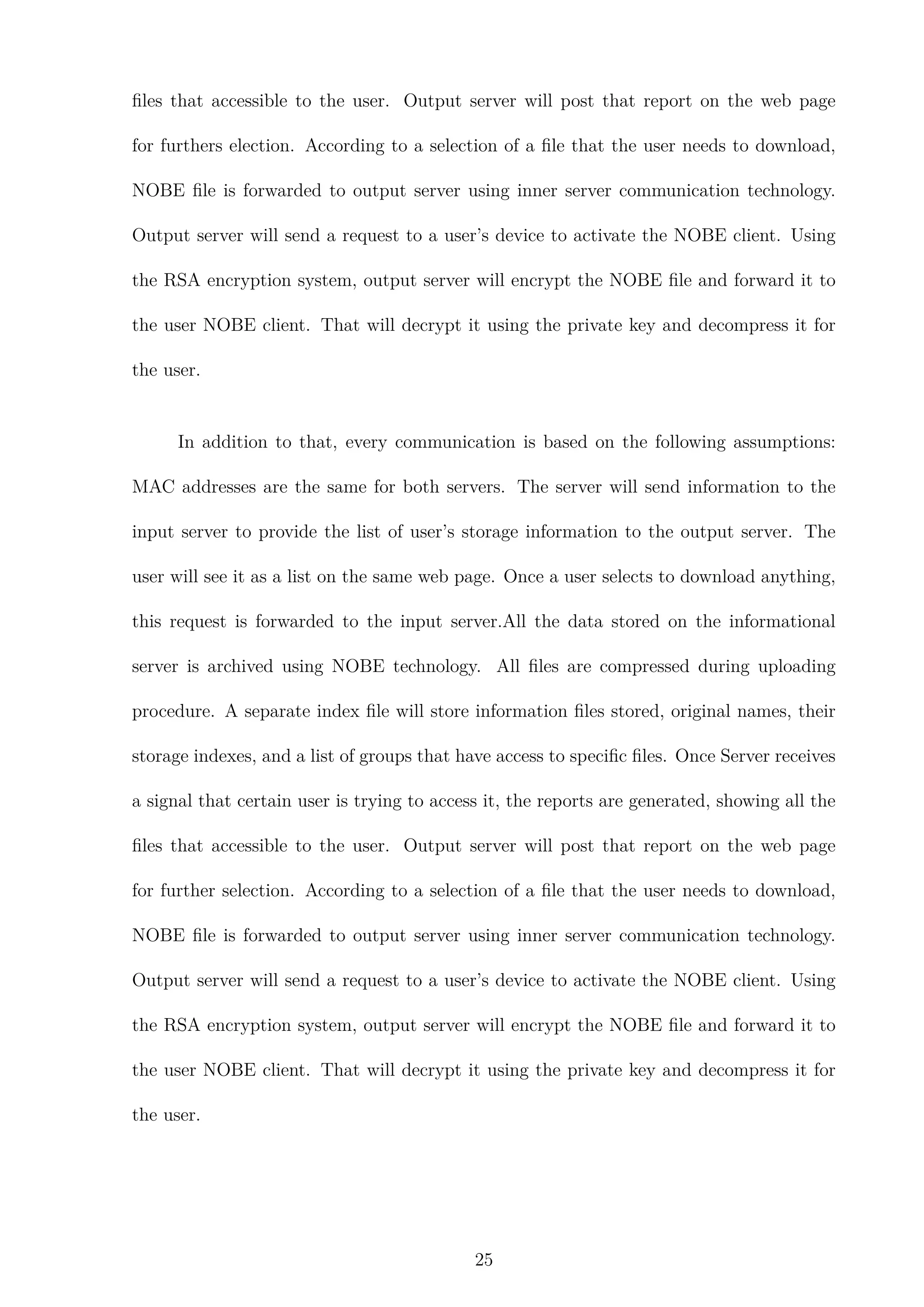



![CHAPTER 8
Advantages of Using PRE for Secure Sharing
Dropbox [4], SugarSync [5], Box, and Soonr are security black holes, while all user files
are encrypted in transit and at rest, the user is not in control of the encryption keys.
These keys are managed by the internal key-servers and are not revealed to the user at
any point in time. However, they claim that the keys are stored in encrypted form for all
other purposes. The advantages of PRE are:
1. The owner of the file has the sole responsibility for providing and revoking access
to the files.
2. Sharing is straightforward with no overhead for the file owner.
3. Offers end-to-end security for files while sharing them.
4. Military-grade security could be achieved using the state of the art encryption mech-
anism like AES-256.
5. Uses advanced proxy re-encryption with multi-hop so that consecutive sharing is
possible.
29](https://image.slidesharecdn.com/report-191129123845/75/Secure-Cloud-Storage-38-2048.jpg)
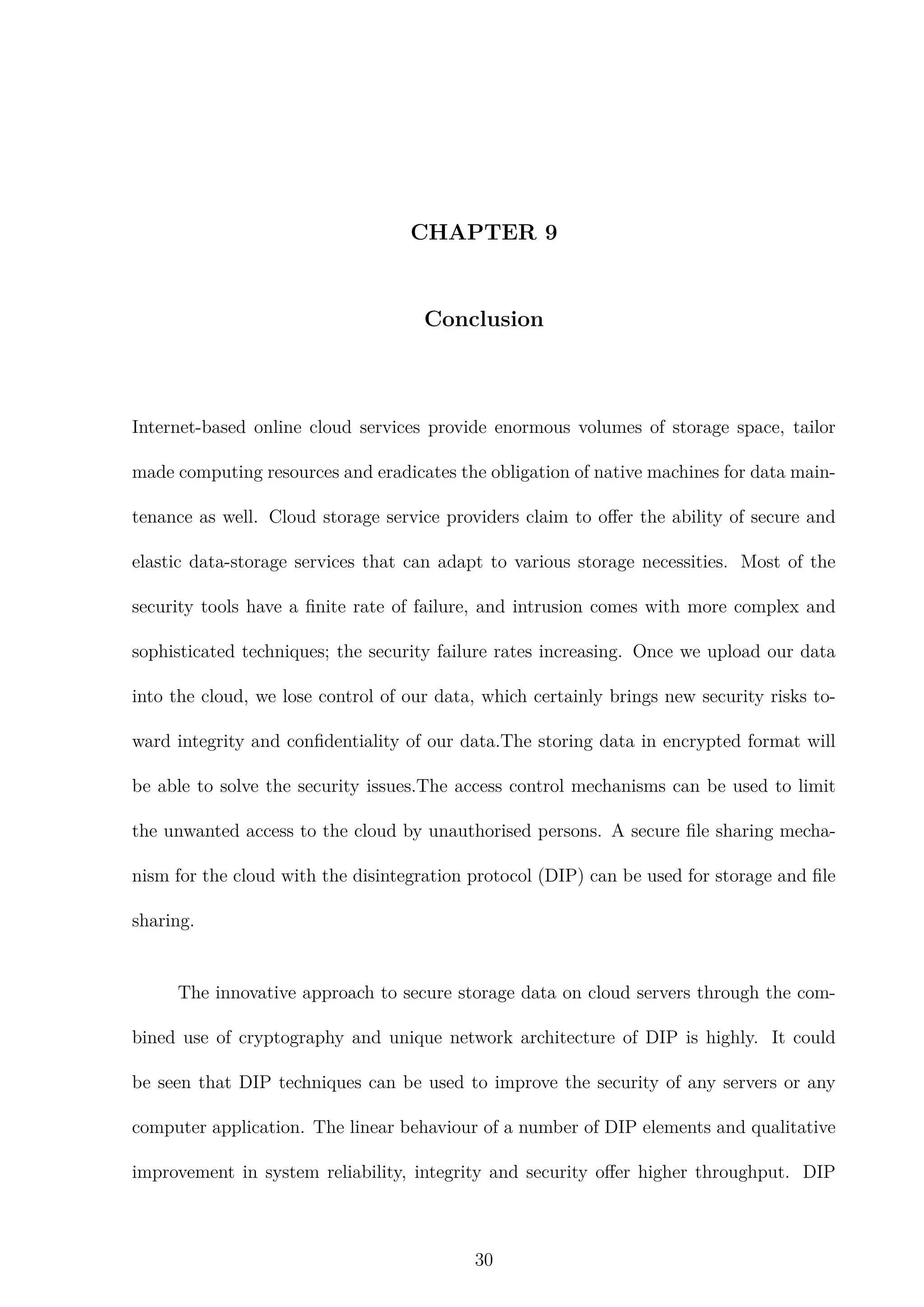

![REFERENCES
[1] Bharat S Rawal and S Sree Vivek. “Secure cloud storage and file sharing”. In 2017
IEEE International Conference on Smart Cloud (SmartCloud), pages 78–83. IEEE,
2017.
[2] B. Avinash, T. Harish, G. Karthikeyan, and Prof. D. Vinodha. “A Survey on proxy
re-encryption method using cloud computing”. International Journal of Research and
Engineering, 4(2):57–59, 2017.
[3] Bharat S Rawal, Harsha K Kalutarage, S Sree Vivek, and Kamlendu Pandey. “The
disintegration protocol: An ultimate technique for cloud data security.”. In 2016 IEEE
International Conference on Smart Cloud (SmartCloud), pages 27–34. IEEE, 2016.
[4] https://www.cloudwards.net/review/dropbox/.
[5] https://www.cloudwards.net/review/sugarsync/.
32](https://image.slidesharecdn.com/report-191129123845/75/Secure-Cloud-Storage-41-2048.jpg)